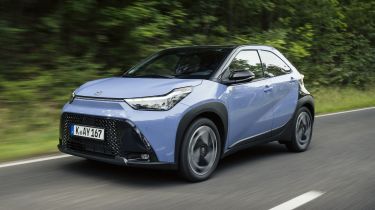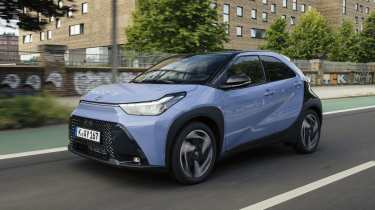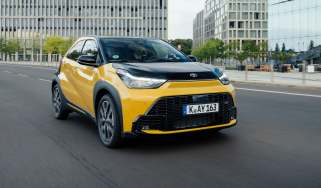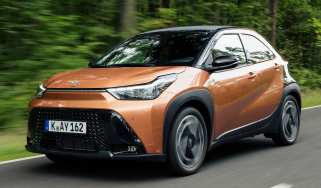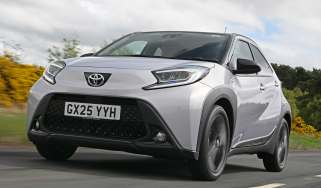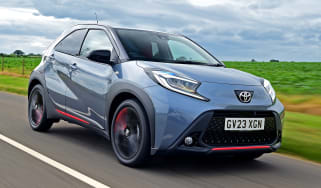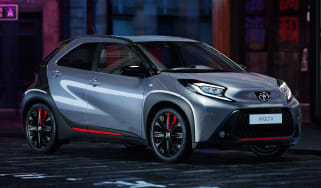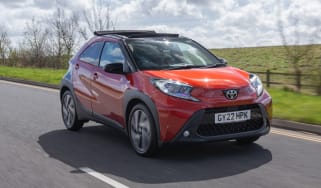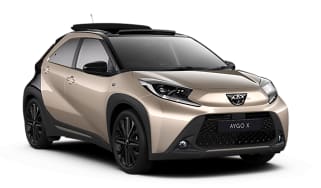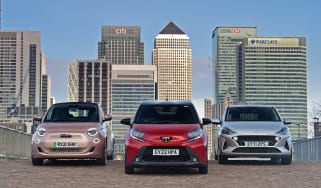Toyota Aygo X review
Compact, charismatic and curiously potent, we think there’s lots to love about the Aygo X

Our opinion on the Toyota Aygo X
The Toyota Aygo X is ultimately an evolution of its rudimentary forebears. The cabin is very tight, and the dash is relatively basic both in terms of layout and practicality. However, the car really over-delivers when up and running. The hybrid engine is not just a substantial improvement in terms of performance and refinement, it’s also far more efficient, with 86mpg reached on our test. It’s even quite a giggle to drive around corners.
About the Toyota Aygo X
The Toyota Aygo was one of the original sub-supermini-sized city cars, packing perky three-cylinder power, lots of scope for personalisation and just enough space for four people. The first iteration of Toyota’s dinky urban runabout was produced from 2005 to 2014, with its follow-up lasting up until 2021. Many other brands have stepped away from the city car segment in that time, but Toyota clearly wasn’t ready to throw in the towel just yet, launching the Aygo X in 2022, and then updating it with a hybrid powertrain in 2025.
The first two generations of Aygo were mechanically identical sister cars to the Citroen C1 and Peugeot 108, with all three being built in the same factory in the Czech Republic. But with the Aygo X, Toyota decided to make the most of its in-house know-how and use a shortened version of the platform that underpins its Yaris supermini.
Used - available now

2020 Jaguar
F-Pace
41,363 milesAutomaticDiesel2.0L
Cash £17,500
2023 Volvo
V60
52,597 milesAutomaticPetrol2.0L
Cash £18,999
2022 Volkswagen
ID.4
14,603 milesAutomaticElectric
Cash £18,897
2023 Hyundai
Tucson
16,735 milesAutomaticPetrol1.6L
Cash £24,176The difference now is that while the previous Aygo X was powered by the same ancient and rather old-fashioned three-cylinder petrol engine, this new Hybrid version has also adopted the entry-level Yaris’s engine, making it the only full-hybrid option in the city car class.
Toyota Aygo X prices and latest deals
UK prices for the Aygo X start from just over £21,500, which is significantly more than our favourite city car, the Kia Picanto, which starts at around £17,000. The top-of-the-range GR Sport trim comes in at just under £27,000. This is a generous bump in price compared to the original Aygo X, but then both performance and kit are substantially upgraded in today’s car.
Check out our latest new car deals, leasing deals and used car deals for the top offers available on the previous Aygo X now on Auto Express. And don't forget we can help you sell your car, too.
Performance & driving experience
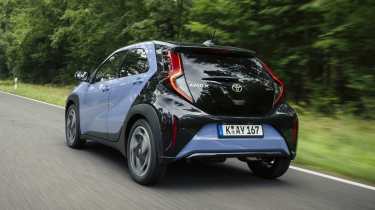
Pros |
|
Cons |
|
There’s only one powertrain option in the new Aygo X Hybrid, and it’s – you guessed it – a hybrid. The package combines a 1.5-litre three-cylinder petrol engine with a small electric motor and battery pack, powering the front wheels through a CVT transmission.
This exact powertrain is already available in the Toyota Yaris and Yaris Cross, but both of those cars are significantly bigger, meaning the job of fitting this powertrain in the Aygo X might have been a big problem. But this isn’t the case.
Since the Aygo X is on a shortened Yaris platform in its last re-design, the petrol engine, electric motor and gearbox was a relatively easy fit under the bonnet. Toyota did lengthen the car’s nose ever so slightly, but it doesn’t look unnatural or cobbled together.
A greater challenge was presented when considering the battery, though, as the placement in a block under the rear seats was no longer an option. As a result, Toyota had to split the small 0.8kWh battery into two banks and arrange them directly under the rear seat cushions. This has pushed up the front of the seat base, leading to a slightly odd rear seating position, which we’ll touch on later.
To do this, while also leaving enough space for a fuel tank, the floor was redesigned entirely - an engineering challenge for the European-based development team. All this work was worth it, though, due to the improvements to both power and efficiency.
| Model | Power | 0-62mph | Top speed |
| Aygo X Hybrid | 114bhp | 9.2 seconds | 106mph |
Performance, 0-60mph acceleration and top speed
Performance is one of the big gains within the latest Aygo X. It’s considerably better than the last generation, the little Toyota being a whole 5.7 seconds faster to 62mph than the previous generation car. 0-62mph is now dispatched in 9.2 seconds, which isn’t just impressive for a city car, but any car.
Peak power for the hybrid system in this new car is 115bhp, 36bhp more than the old non-hybrid model – and you can feel every one of those horses in action. Even better, the hybrid’s 141Nm of torque isn’t just more than before, it’s also aided by a chunk of electric assistance, so the car feels significantly faster in real-world conditions.
Town driving, visibility and parking
Thanks to the added get-up-and-go from its hybrid powerplant, the Aygo X is about as good a town car as any ICE rival, thanks to zippy performance and a seamless transmission. Being a CVT, there are no traditional gears, meaning the car will hold the revs at the point when it’s generating peak power. These types of gearboxes can feel a little unnatural and droney, but the Aygo X’s gearbox is quick to calm down, letting the revs fall once you’re off the throttle. Noise and vibration suppression are significantly improved over the previous generation, too.
The Aygo X has considerable electric-only performance too, and will easily run more than 50 per cent of the time on e-power alone. Toyota did suggest this could be up to 80 per cent of the time during our initial test drive around Berlin, but that would require a very gentle right foot. A bit more information about how much throttle travel you have left before the ICE engine kicks in to help the e-motor would be a nice touch, but the powertrain is still a brilliant little urban ally in any case.
Visibility up front is very good, but the small rear door glass and dark roof make rearward vision a little difficult. The Aygo X is very easy to drive, though, and with an ever-so-slightly raised seating position compared to the average city car, it’s also a cinch to park. The ride is very well controlled, and thanks to what feels like a lack of overall weight, it seems to skip over road imperfections, rather than crashing into them.

Country road driving and handling
Out of town driving is where city cars and hybrids can come unstuck, but the hybrid Aygo X city car once again impresses with spritely performance and an effortless gait. In the old Aygo X, pulling out onto main roads from a stop required some level of planning, as the near 15-second 0-62mph time could make it quite tricky just to keep up with traffic.
The new model is much, much more comfortable out on the open road, and makes the process of driving down fast roads feel effortless. We also think the handling and ride quality are generally impressive, with the car showing an ability to handle bumps and ridges in the road that goes far beyond other city car options. The Aygo X’s Yaris-derived chassis definitely helps here.
Motorway driving and long-distance comfort
The improvements made to the Aygo X are just as evident on motorways, where the car is far more capable than not only the last Aygo X, but also most of its rivals. The engine is quick to settle at a cruise, and the big wheels and secure suspension keep it from being blown off-course by crosswinds.
All generations of Aygo and Aygo X have been able to traverse high-speed motorways without too much drama in the past, but none have done it with anywhere near as much ease as the latest hybrid model.
One area the Aygo X doesn’t quite match larger superminis is refinement, as the lightweight body doesn’t quite have the same level of insulation from road noise as more sophisticated superminis, but it’s competitive for a city car.
“The new Aygo X’s performance is actually rather startling – not that it feels overpowered, rather completely effortless in a way no Aygo X, and few city cars, ever have.” – Jordan Katsianis, senior staff writer.
MPG & running costs

Pros |
|
Cons |
|
Getting straight to the point, the new Aygo X Hybrid is about the most efficient non-plug-in hybrid car on sale right now. Toyota claims an MPG figure on the WLTP combined cycle of 78.3mpg, with a CO2 figure of 85h/km.
The amazing thing with the Aygo X, though, is that it’s not just possible to match that official figure in the real world, you can even beat it with relative ease. On our test, we managed as much as 86mpg on a combination of motorways, A-roads and urban driving, which is frankly incredible. Even when using the full performance from the powertrain later in the day, we still managed around 80mpg.
| Model | MPG | CO2 | Insurance group |
| Aygo X Hybrid | 78.8mpg | 85g/km | TBC |
Insurance groups
Insurance classes have yet to be confirmed for the new hybrid-powered Aygo X, but previous models sat in a very low group of between 5 and 8. The added complexity of the hybrid system is likely to see this rise a little, but it’ll still be one of the most affordable cars to insure on the market, making it perfect for young drivers.
Tax
The initial VED tax rate for the Aygo X Hybrid will be in the £270 bracket, but it is added to the asking price at the point of purchase. Beyond that, the flat £195 fee will apply.
Depreciation
The Aygo X has always had excellent residuals due to Toyota’s reputation for reliability and low running costs. This might dip a little due to the new model’s higher asking price, but the even more efficient hybrid powertrain will make the car even more desirable for second-hand buyers looking for a cheap set of wheels.
To get an accurate valuation on a specific model check out our free car valuation tool...
Interior, design & technology
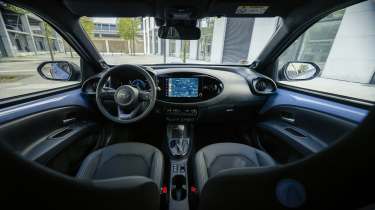
Pros |
|
Cons |
|
It might be all revolution underneath the latest Aygo X, but the skin itself is very familiar territory for Toyota’s tiny city car. The name of the game is funky shapes, bi-colour paintwork and big wheels, which are available at up to 18 inches in size.
Alongside the base car with its blocky headlights and massive grille is a GR Sport trim. This gives the nose an even chunkier appearance, and if specified in white, it makes the Aygo X look a little like a miniature GR Yaris hot hatch.
Interior and dashboard design
The cabin is much the same, sharing its somewhat bulbous dashboard architecture with the old model. There are some elements which feel a little too simple or pared back, considering the car’s price point. The design is quite funky, though, and there are some cool new fabrics and colour splashes on the dash.
Materials and build quality
Cabin materials are fairly simple, with not much in the way of soft-touch plastics anywhere around the elements you touch. Key touchpoints, like the steering wheel, gear selector, and door pulls all have a relative Toyota-like heft, though, and the interior feels well screwed together.
Infotainment, sat-nav and stereo
While the cabin at large hasn’t really changed, the tech very much has, as the Aygo X Hybrid introduces a new set of digital interfaces. In front of the driver, the semi-digital instrument cluster of the last model has been replaced with a full-size colour display that has a reasonable amount of variability in its layout.
Entry-level Icon and mid-range Design come with a nine-inch touchscreen infotainment system, while Excel and GR Sport trims feature a larger 10.5-inch display borrowed from other Toyota models. The latter dominates the dash is a new 10.5-inch display and utilises the brand's latest user interface style. This screen size might not sound like much on paper, but in context of the tiny cabin, it feels huge – like mounting a 60-inch TV in a cupboard.
The integrated system works well, but it’s best when hooked up to Apple CarPlay or Android Auto. High-end Excel and GR Sport trims gain wireless smartphone charging.
There are a set of separate climate controls which are super easy to use and well placed.
“The Aygo X Hybrid’s rudimentary origins are most obvious in the cabin. When did it become okay to omit central air vents in a modern car?” – Jordan Katsianis, senior staff writer
Boot space & practicality
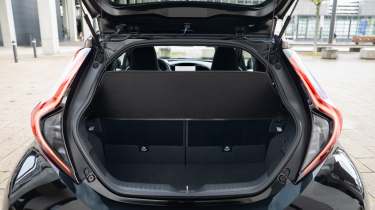
Pros |
|
Cons |
|
An Aygo X Hybrid might not drive or be priced like a city car, but cabin space hasn’t quite moved up to the next rung on the ladder with these aspects. The interior of this car is small, to the point where the second row can be uncomfortable for anyone larger than a 12-year old child. This is only heightened by the oddly-shaped rear seat bases, and the tiny pop-out rear windows.
Dimensions and size
The Aygo X is fairly standard in size compared to other city cars, except that its mini-SUV design makes it a little taller than the likes of the Kia Picanto and Hyundai i10. Toyota’s Yaris is one of the smaller superminis but it’s still significantly larger than the Aygo X.
| Dimensions comparison | |||
| Model | Toyota Aygo X | Kia Picanto | Toyota Yaris |
| Length | 3,667mm | 3,605mm | 3,940mm |
| Width | 1,740mm | 1,880mm | 1,745mm |
| Height | 1,625mm | 1,485mm | 1,500mm |
| Wheelbase | 2,430mm | 2,400mm | 2,550mm |
| Boot space | 231 litres | 255 litres | 286 litres |
Seats & passenger space
Similar to many city cars, the Aygo X’s seats lack lateral support in the bends, and don’t feel particularly comfortable over long journeys. Packaging is also tight, with the dashboard feeling a little too bulbous in a way that feels like it’s intruding into the cabin space.
The rear seats are very tight, and thanks to small rear windows and a dark headlining, it can feel a little claustrophobic. The seat base is also tilted upwards towards the end of the cushion in order to fit the batteries underneath, making for a slightly awkward seating position that puts the rear passenger’s knees a little too high for comfort. The hip-point of rear-seat passengers isn’t any higher, though, so overall rear space isn’t massively compromised over the previous non-hybrid Aygo X. The car is also a strict four seater, with no centre seat or belt in the back, and the rear doors feel awkwardly small to get in and out of.

Boot space
Actual bootspace isn’t that bad, at 231-litres, but the space is devoid of any tricks to boost practicality and can be tricky to access. The loading lip is high on account of the simple one-piece glazed tailgate, and there’s no false floor to reduce it. The seats are a simple 50/50 split, and leave a lip in the middle of the load area when folded down – again, a simple false floor would help negate this.
“Practicality is where the Aygo X’s city-car nature bites back, with limited space and not much in the way of clever tricks to make the most of it” – Jordan Katsianis, senior staff writer
Reliability & safety
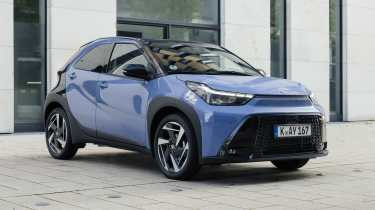
Pros |
|
Cons |
|
Toyota’s strong reputation for reliability isn’t to be taken lightly with its models, backed up by an excellent warranty service. The basic coverage is three years or 60,000 miles, but if you continue to get the car serviced at a Toyota main dealer, it’ll extend the warranty period for a further 12 months per service, all the way to 10 years, or 100,000 miles – whichever occurs first.
The latest hybrid-powered Aygo X is too new to have been included in our Driver Power Survey; however, four popular models, including two that share a powertrain with the Aygo X in the Yaris and Yaris Cross, all performed relatively well, but particularly shone in reliability and running costs.
The Aygo X Hybrid received a four-star Euro NCAP rating after being tested in 2025. That seems similar to the four-star result the previous Aygo X received in 2022, but the test has since become more stringent, so it's impressive that it has at least maintained the same star rating. However, there are a growing number of small electric cars, such as the BYD Dolphin Surf, that earn the maximum five-star rating, which you might want to consider if safety is your paramount concern.
Every model is equipped with a Pre-Collision System with day and night Pedestrian detection, and daytime cyclist detection, intelligent adaptive cruise control (iACC), driver attention alert, road sign assist, reversing camera and six airbags. A Parking Pack is available as an option on Icon and Design trims (standard on Excel and GR Sport trims) that includes front and rear parking sensors.
| Euro NCAP safety ratings | |
| Euro NCAP safety rating | 4 stars (NCAP, 2025) |
| Adult occupant protection | 73 |
| Child occupant protection | 72 |
| Vulnerable road user protection | 83 |
| Safety assist | 68 |
Buying and owning
Best buy: Toyota Aygo X Icon
There really is no bad spec, so with a good level of equipment across all models of Aygo X, we’d suggest that even a basic Aygo X Hybrid Icon is the best version to go for, especially considering how much more it is when compared with our favourite city car, the Kia Picanto.
Toyota Aygo X alternatives
The city car class isn’t packed with options these days, as core rivals for the Aygo X are limited to the Hyundai i10 and Kia Picanto. Neither of these is available in a hybrid form, but they do feel more substantial inside and out. There’s also more choice offered in their specs, and they have manual gearbox options. However, neither is close to the Aygo X in terms of power or efficiency, and the Aygo drives better, too.
This may change with a selection of new EV rivals on the cusp of being launched. These include a new Volkswagen model based on the ID.1 concept – likely to be called ID. Lupo – and there’s a new generation electric Renault Twingo on its way as well. Both of these European-designed models are expected to undercut the Toyota on price, too.
Deals on the Toyota Aygo X and alternatives
Toyota Aygo X pictures
Key updates of the Toyota Aygo X review
- 11 December 2025: update to include pricing and the latest Euro NCAP safety rating.
Frequently Asked Questions
Yes, the Toyota Aygo X is a brilliant car, but its most appealing attributes aren’t what you might expect. Unusually for a car in this class, performance is the Aygo X’s biggest asset, with excellent efficiency a nice bonus. Aside from this, limitations in terms of practicality are brought into focus more acutely by its high price.

